中国园林英语简介
- 格式:ppt
- 大小:4.96 MB
- 文档页数:10
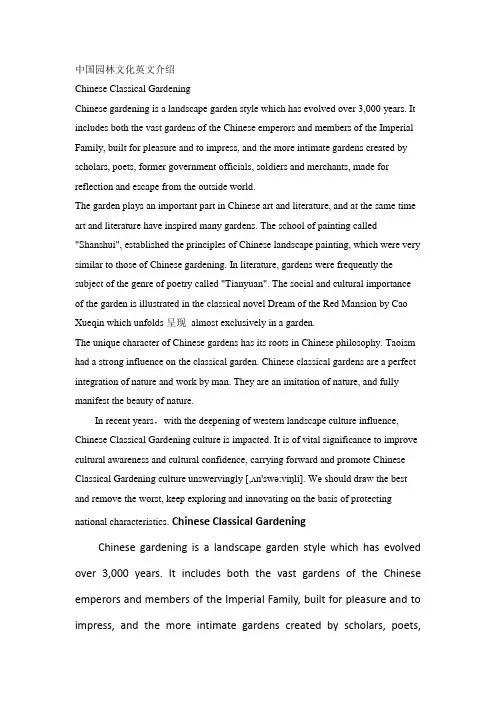
中国园林文化英文介绍Chinese Classical GardeningChinese gardening is a landscape garden style which has evolved over 3,000 years. It includes both the vast gardens of the Chinese emperors and members of the Imperial Family, built for pleasure and to impress, and the more intimate gardens created by scholars, poets, former government officials, soldiers and merchants, made for reflection and escape from the outside world.The garden plays an important part in Chinese art and literature, and at the same time art and literature have inspired many gardens. The school of painting called "Shanshui", established the principles of Chinese landscape painting, which were very similar to those of Chinese gardening. In literature, gardens were frequently the subject of the genre of poetry called "Tianyuan". The social and cultural importance of the garden is illustrated in the classical novel Dream of the Red Mansion by Cao Xueqin which unfolds呈现almost exclusively in a garden.The unique character of Chinese gardens has its roots in Chinese philosophy. Taoism had a strong influence on the classical garden. Chinese classical gardens are a perfect integration of nature and work by man. They are an imitation of nature, and fully manifest the beauty of nature.In recent years,with the deepening of western landscape culture influence, Chinese Classical Gardening culture is impacted. It is of vital significance to improve cultural awareness and cultural confidence, carrying forward and promote Chinese Classical Gardening culture unswervingly [,ʌn'swə:viŋli]. We should draw the best and remove the worst, keep exploring and innovating on the basis of protecting national characteristics. Chinese Classical GardeningChinese gardening is a landscape garden style which has evolved over 3,000 years. It includes both the vast gardens of the Chinese emperors and members of the Imperial Family, built for pleasure and to impress, and the more intimate gardens created by scholars, poets,former government officials, soldiers and merchants, made for reflection and escape from the outside world.The garden plays an important part in Chinese art and literature, and at the same time art and literature have inspired many gardens. The school of painting called "Shanshui", established the principles of Chinese landscape painting, which were very similar to those of Chinese gardening. In literature, gardens were frequently the subject of the genre of poetry called "Tianyuan". The social and cultural importance of the garden is illustrated in the classical novel Dream of the Red Mansion by Cao Xueqin which unfolds呈现almost exclusively in a garden.The unique character of Chinese gardens has its roots in Chinese philosophy. Taoism had a strong influence on the classical garden. Chinese classical gardens are a perfect integration of nature and work by man. They are an imitation of nature, and fully manifest the beauty of nature.In recent years,with the deepening of western landscape culture influence, Chinese Classical Gardening culture is impacted. It is of vital significance to improve cultural awareness and cultural confidence, carrying forward and promote Chinese Classical Gardening culture unswervingly [,ʌn'swə:viŋli]. We should draw the best and remove the worst, keep exploring and innovating on the basis of protecting national characteristics.。

中国园林英语作文Chinese GardenChinese garden is a traditional style of garden design that has evolved over thousands of years. It is a unique form of art that combines architecture, poetry, painting, and horticulture. Chinese garden design is characterized by its naturalistic style, with an emphasis on creating a harmonious and balanced relationship between man and nature.The elements of a Chinese garden typically include water, rocks, plants, and architecture. Water is a central feature in Chinese gardens, symbolizing life and tranquility. Rocks are used to create a sense of ruggedness and permanence, while plants are chosen for their seasonal beauty and symbolic meanings. The architecture in Chinese gardensoften includes pavilions, bridges, and corridors, which are carefully integrated into the natural landscape.One of the most famous Chinese gardens is the Classical Gardens of Suzhou, which is a UNESCO World Heritage site. These gardens are known for their exquisite design,intricate layout, and poetic symbolism. Each garden is amasterpiece of art and nature, with its own unique features and historical significance.Chinese gardens are not only places of beauty and tranquility, but also important cultural symbols. They reflect the Confucian philosophy of harmony and balance, as well as the Taoist belief in the unity of man and nature. Chinese gardens are also a source of inspiration for artists, poets, and scholars, who have long been drawn to their timeless beauty and spiritual significance.中国园林中国园林是一种源远流长的园林设计风格,融合了建筑、诗歌、绘画和园艺,是一种独特的艺术形式。
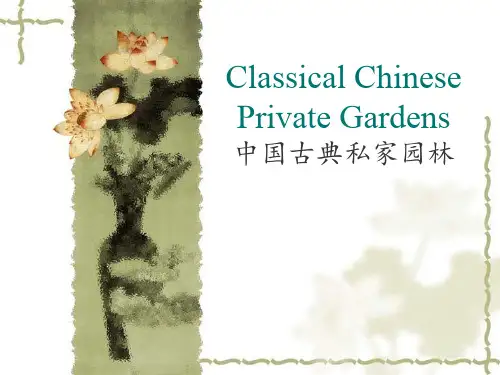
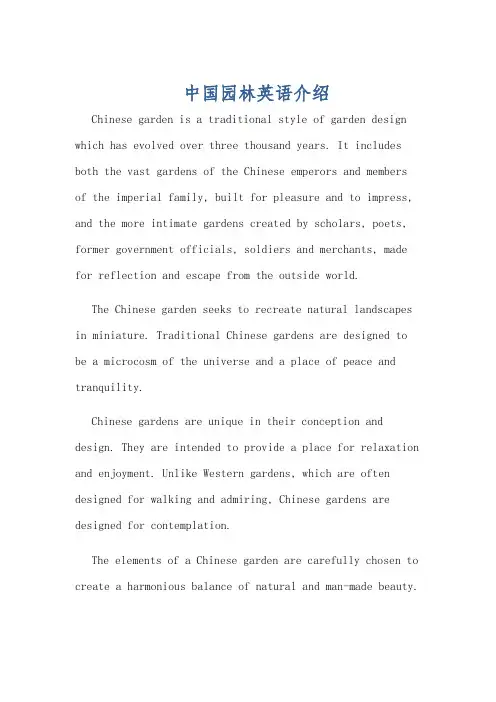
中国园林英语介绍Chinese garden is a traditional style of garden design which has evolved over three thousand years. It includes both the vast gardens of the Chinese emperors and members of the imperial family, built for pleasure and to impress, and the more intimate gardens created by scholars, poets, former government officials, soldiers and merchants, made for reflection and escape from the outside world.The Chinese garden seeks to recreate natural landscapes in miniature. Traditional Chinese gardens are designed to be a microcosm of the universe and a place of peace and tranquility.Chinese gardens are unique in their conception and design. They are intended to provide a place for relaxation and enjoyment. Unlike Western gardens, which are often designed for walking and admiring, Chinese gardens are designed for contemplation.The elements of a Chinese garden are carefully chosen to create a harmonious balance of natural and man-made beauty.Rocks, water, plants, and architecture are used to create a sense of harmony and balance.In a Chinese garden, the use of water is of utmost importance. Water is considered the source of life, and its presence is essential for creating a sense of tranquility and balance.Plants in a Chinese garden are carefully chosen and arranged to create a sense of natural beauty. Trees, flowers, and other plants are selected for their shape, color, and fragrance to create a harmonious composition.Rocks are another important element in a Chinese garden. They are chosen for their shape, color, and texture, and are carefully arranged to create a sense of balance and harmony.Architecture in a Chinese garden is also carefully chosen to create a sense of harmony and balance. Pavilions, bridges, and other structures are designed to blend in with the natural surroundings and to provide a place for contemplation and relaxation.中文园林是中国传统的园林设计风格,已经发展了三千多年。
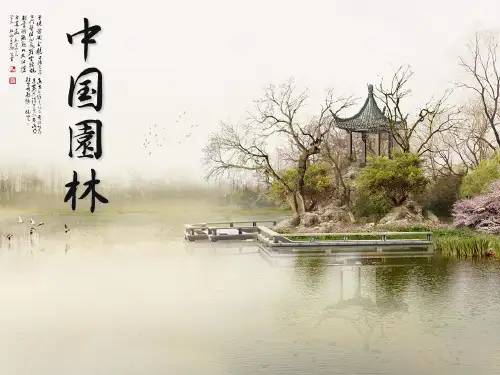

关于“拙政园”的英文短文介绍(3篇)拙政园,是中国最著名的古典园林之一,被誉为“中国四大名园”之首。
其历史悠久,至今已有近六百年的历史。
拙政园以其独特的园林艺术,精湛的建筑技艺,丰富的文化内涵,被誉为“中国园林的瑰宝”。
下面我们就用简短的英文短文来介绍一下这个美丽的江南水乡园林,让更多人知道这个地方吧!短文介绍1:Humble Administrator's Garden,located in Suzhou,Jiangsu Province,China,is one of the famous classical gardens in China and an important component of the World Cultural Heritage.The garden integrates various elements such as mountains and rivers,gardens,architecture,and culture,showcasing the unique charm of traditional Chinese culture.The design of Humble Administrator's Garden is exquisite,with mountains and rivers as the theme,architecture as the auxiliary,and culture as the soul.Through the use of various artistic techniques,it creates a garden landscape that combines natural beauty with cultural charm.There are various buildings and scenic spots in the park,such as rockeries,ponds,pavilions,small bridges,and flowing water.Every corner exudes a strong cultural atmosphere.At the Humble Administrator's Garden,tourists can experience theessence of traditional Chinese gardens and appreciate the breadth and depth of Chinese culture.Whether strolling along winding paths or leaning against antique pavilions,one can enjoy beautiful natural scenery and a rich cultural atmosphere.This is a place where people can find peace of mind and feel the charm of traditional Chinese culture.In short,the Humble Administrator's Garden is a garden that combines natural beauty,cultural charm,and artistic elegance,and is an outstanding representative of traditional Chinese culture.Whether you are a garden enthusiast or a tourist interested in Chinese culture,you should not miss such a beautiful place.短文介绍1中文翻译:拙政园,位于中国江苏省苏州市,是中国著名的古典园林之一,也是世界文化遗产的重要组成部分。
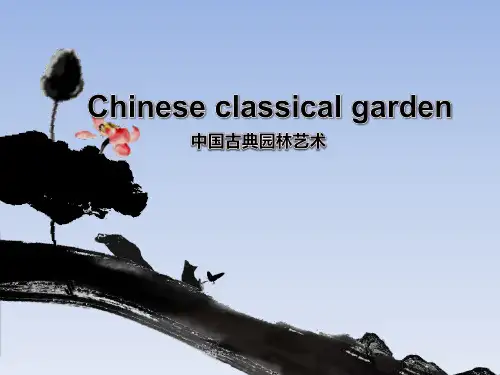
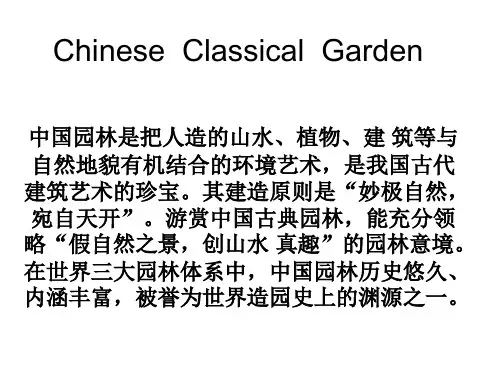
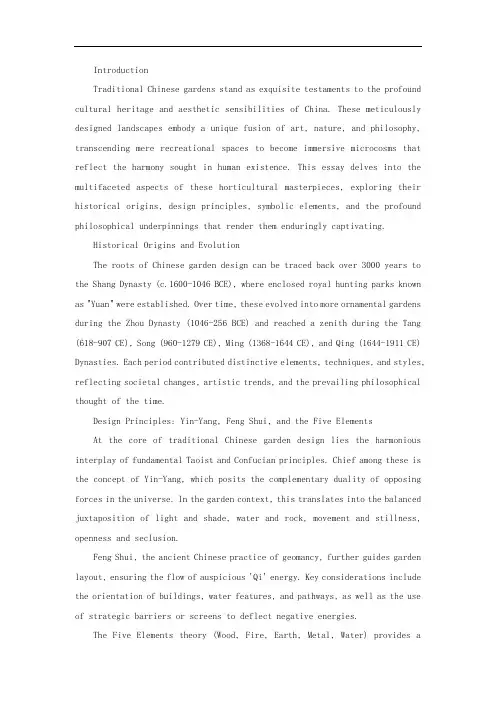
IntroductionTraditional Chinese gardens stand as exquisite testaments to the profound cultural heritage and aesthetic sensibilities of China. These meticulously designed landscapes embody a unique fusion of art, nature, and philosophy, transcending mere recreational spaces to become immersive microcosms that reflect the harmony sought in human existence. This essay delves into the multifaceted aspects of these horticultural masterpieces, exploring their historical origins, design principles, symbolic elements, and the profound philosophical underpinnings that render them enduringly captivating.Historical Origins and EvolutionThe roots of Chinese garden design can be traced back over 3000 years to the Shang Dynasty (c.1600-1046 BCE), where enclosed royal hunting parks known as "Yuan" were established. Over time, these evolved into more ornamental gardens during the Zhou Dynasty (1046-256 BCE) and reached a zenith during the Tang (618-907 CE), Song (960-1279 CE), Ming (1368-1644 CE), and Qing (1644-1911 CE) Dynasties. Each period contributed distinctive elements, techniques, and styles, reflecting societal changes, artistic trends, and the prevailing philosophical thought of the time.Design Principles: Yin-Yang, Feng Shui, and the Five ElementsAt the core of traditional Chinese garden design lies the harmonious interplay of fundamental Taoist and Confucian principles. Chief among these is the concept of Yin-Yang, which posits the complementary duality of opposing forces in the universe. In the garden context, this translates into the balanced juxtaposition of light and shade, water and rock, movement and stillness, openness and seclusion.Feng Shui, the ancient Chinese practice of geomancy, further guides garden layout, ensuring the flow of auspicious 'Qi' energy. Key considerations include the orientation of buildings, water features, and pathways, as well as the use of strategic barriers or screens to deflect negative energies.The Five Elements theory (Wood, Fire, Earth, Metal, Water) provides aframework for selecting materials, colors, and plant species, each representing a specific element and its associated attributes. These elements interact and transform, symbolizing the cyclical nature of life and fostering an environment of vitality and balance.Spatial Organization and the Principle of Borrowed SceneryTraditional Chinese gardens are characterized by a highly nuanced spatial organization that encourages exploration and discovery. They often comprise several distinct yet interconnected zones, such as the entrance court, the central lake, the scholar's studio, and the bamboo grove, each with its unique mood and function.A key design technique employed is "Jing Tuo Shanshui," or "borrowed scenery." This involves strategically situating openings, windows, or pavilions to frame external views, integrating distant landscapes into the garden as if they were part of the composition. This not only expands the visual boundaries of the garden but also creates a sense of continuity between the man-made and natural worlds, echoing the Taoist principle of unity between humanity and nature.Symbolic Elements: Water, Rock, Plants, and ArchitectureWater is a vital element in Chinese gardens, symbolizing life, purification, and renewal. It is often featured in various forms – tranquil ponds, meandering streams, cascading waterfalls, or reflective pools – and serves both aesthetic and functional purposes, providing habitats for aquatic life and cooling the surrounding environment.Rockeries, crafted from limestone or granite, represent the immutable strength and endurance of nature. Their shapes, textures, and placements are carefully chosen to evoke mountains, caves, or islands, creating miniature landscapes within the garden. The juxtaposition of rugged rocks and delicate flora underscores the concept of Yin-Yang.Plants play a crucial role in evoking seasonal change, poetic allusions, and moral virtues. Bamboo, for instance, symbolizes resilience and integrity;plum blossoms, perseverance in adversity; and lotus, purity amidst turmoil. Trees, flowers, and herbs are selected for their fragrance, color, and medicinal properties, enriching the sensory experience and fostering a connection with nature.Architecture in Chinese gardens is characterized by elegant simplicity, blending seamlessly with the surrounding landscape. Pavilions, bridges, pagodas, and verandas serve as vantage points, resting spots, or venues for cultural activities. Their designs often incorporate intricate latticework, calligraphy, and paintings, adding layers of meaning and cultural reference.Philosophical Underpinnings: Taoism, Confucianism, and BuddhismThe essence of traditional Chinese gardens lies in their embodiment of profound philosophical and spiritual concepts. Taoism's emphasis on naturalness, spontaneity, and the unity of opposites finds expression in the garden's organic forms, asymmetrical layouts, and the interplay of contrasting elements. The garden becomes a tangible manifestation of the Tao, inviting contemplation and inspiring a return to one's innate harmony with the cosmos.Confucian ideals of order, propriety, and self-cultivation are reflected in the structured spatial arrangements, the integration of scholarly pursuits such as poetry, painting, and calligraphy, and the use of symbolic elements that evoke moral virtues. Gardens often feature the "Scholar's Studio," a serene retreat for intellectual and artistic endeavors, reinforcing the connection between nature and wisdom.Buddhist influences, particularly Zen Buddhism, are evident in the emphasis on meditation, mindfulness, and the appreciation of transience. The garden's carefully choreographed vistas, the soothing sounds of water, and the changing seasonal flora encourage visitors to slow down, reflect, and cultivate inner peace.ConclusionTraditional Chinese gardens are not mere green spaces but living expressions of China's rich cultural heritage, philosophical depth, and artistic genius.Through their masterful integration of natural elements, architectural features, and symbolic motifs, they transcend physical boundaries, offering visitors a transcendent journey through time, space, and the human spirit. These verdant sanctuaries continue to inspire awe and contemplation, serving as timeless reminders of our innate connection to nature and the eternal quest for harmony and enlightenment.(Word Count: 1494)。
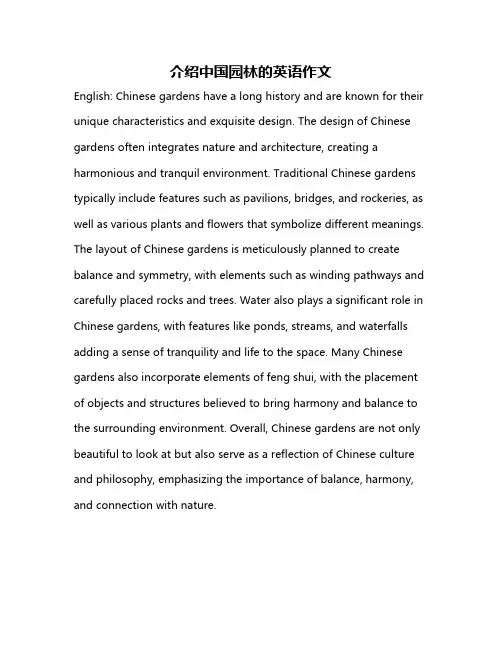
介绍中国园林的英语作文English: Chinese gardens have a long history and are known for their unique characteristics and exquisite design. The design of Chinese gardens often integrates nature and architecture, creating a harmonious and tranquil environment. Traditional Chinese gardens typically include features such as pavilions, bridges, and rockeries, as well as various plants and flowers that symbolize different meanings. The layout of Chinese gardens is meticulously planned to create balance and symmetry, with elements such as winding pathways and carefully placed rocks and trees. Water also plays a significant role in Chinese gardens, with features like ponds, streams, and waterfalls adding a sense of tranquility and life to the space. Many Chinese gardens also incorporate elements of feng shui, with the placement of objects and structures believed to bring harmony and balance to the surrounding environment. Overall, Chinese gardens are not only beautiful to look at but also serve as a reflection of Chinese culture and philosophy, emphasizing the importance of balance, harmony, and connection with nature.中文翻译: 中国园林历史悠久,以其独特的特点和精致的设计而闻名。
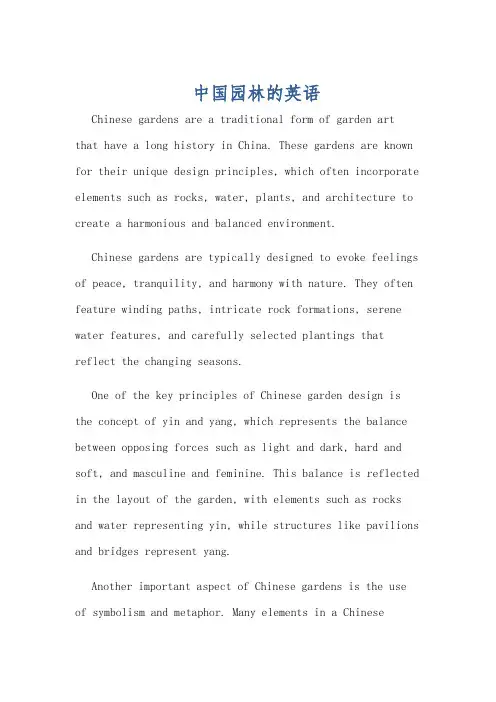
中国园林的英语Chinese gardens are a traditional form of garden artthat have a long history in China. These gardens are known for their unique design principles, which often incorporate elements such as rocks, water, plants, and architecture to create a harmonious and balanced environment.Chinese gardens are typically designed to evoke feelings of peace, tranquility, and harmony with nature. They often feature winding paths, intricate rock formations, serene water features, and carefully selected plantings that reflect the changing seasons.One of the key principles of Chinese garden design is the concept of yin and yang, which represents the balance between opposing forces such as light and dark, hard and soft, and masculine and feminine. This balance is reflected in the layout of the garden, with elements such as rocks and water representing yin, while structures like pavilions and bridges represent yang.Another important aspect of Chinese gardens is the useof symbolism and metaphor. Many elements in a Chinesegarden are chosen for their symbolic meaning, such as the use of bamboo to represent resilience and strength, or the placement of rocks to symbolize mountains or islands.Overall, Chinese gardens are designed to be a place of contemplation and reflection, where visitors can escape from the hustle and bustle of everyday life and connect with nature in a peaceful setting.中国园林是中国传统园林艺术的一种形式,具有悠久的历史。
中国园林博物馆英文介绍The Chinese Garden Museum is a prestigious institution located in China, dedicated to the preservation, research, and exhibition of Chinese traditional gardens. Established in [year], the museum showcases the rich history, cultural significance, and exceptional beauty of Chinese gardens.Spread across an area of [size], the Chinese Garden Museum houses an impressive collection of artifacts, photographs, and documents related to Chinese traditional gardens. The collection spans across different dynasties and regions, reflecting the diverse styles and techniques employed in garden design and construction.The museum is divided into several thematic sections that guide visitors through the history and evolution of Chinese gardens. The first section traces the origins of Chinese garden design, dating back over [number] years. Here, visitors will discover the influence of nature, philosophy, and religion in shaping the conceptual framework of traditional Chinese gardens.Moving forward in time, the museum highlights the development of different garden styles prevalent in China. From the grand imperial gardens of the Ming and Qing dynasties to the intimate scholar’s gardens, each style captures the essence of its respective era. Authentic miniatures of these gardens have been recreated within the museum, allowing visitors to experience the serenity and beauty firsthand.One standout feature of the museum is the comprehensive collection of plant specimens. Chinese gardens are cherished for their intricate use of plants and trees to create harmonious landscapes. The museum’s botanical garden displays a vast array of native and exotic species found in traditional Chinese gardens. Visitors can learn about the symbolism and medicinal value attributed to various plants, as well as their specific role in garden design.To enrich the visitor experience, the Chinese Garden Museum organizes a variety of cultural activities and events. These include traditional music performances, calligraphy and painting workshops, and lectures by renowned garden experts. Visitors can gain a deeper understanding of the artistic and philosophical principles underlying Chinese gardens through these immersive experiences.In addition to its curated exhibitions, the museum supports ongoing research in the field of Chinese garden studies. Scholars and garden enthusiasts from around the world are encouraged to visit the museum's research library and archives. Extensive records, scholarly publications, and rare manuscripts provide a valuable resource for studying the history and significance of Chinese gardens. The Chinese Garden Museum is committed to promoting the conservation and recognition of traditional Chinese gardens as a cultural heritage. It actively collaborates with international organizations and universities to raise awareness about the importance of these gardens in the context of global cultural diversity. The museum also supports initiatives for the preservation of endangered garden sites and offers guidance to individuals interested in creating their own traditional Chinese gardens.A visit to the Chinese Garden Museum is not just an opportunity to explore the beauty of Chinese gardens, but to gain a deeper appreciation for the craftsmanship, aesthetics, and cultural values they embody. Whether you are an art enthusiast, a nature lover, or a curious traveler, the museum promises a memorable and enlightening experience in the world of Chinese gardens.。
Chinese Garden: A Masterpiece of Natureand CultureThe Chinese garden, a profound blend of nature and culture, is a testament to the ancient wisdom and aesthetic sensibilities of the Chinese people. It is not merely a space for relaxation and contemplation, but a microcosm of the universe, reflecting the harmonious coexistence between humanity and nature.At the heart of the Chinese garden lies the philosophy of "Tianren Heyi" - the harmonious unity of Heaven and Man. This philosophy is reflected in every aspect of thegarden's design, from the layout of paths and ponds to the selection of plants and rocks. The garden is designed to mimic natural landscapes, with rolling hills, tinkling streams, and lush vegetation, all arranged in a way that evokes a sense of tranquility and serenity.The art of gardening in China is also deeply influenced by traditional painting and poetry. The gardens are often designed as three-dimensional paintings, with scenes and vistas that change with the seasons and the viewer's perspective. Rocks, trees, and water elements are carefullycomposed to create a harmonious and balanced composition, much like a traditional Chinese landscape painting.Another notable aspect of Chinese gardens is their use of symbolic elements. Rocks, for instance, often represent the solidity and stability of nature, while water symbolizes flexibility and change. Bridges, pagodas, and other architectural features are not just decorative but also serve to enhance the garden's overall theme and atmosphere.The Chinese garden is also a place for intellectual and spiritual pursuits. It provides a serene environment for scholars and poets to meditate, compose, and contemplate. The garden's natural beauty and harmonious atmosphere are thought to foster creativity and introspection.Modern Chinese gardens, while retaining the essence of traditional design, have also incorporated elements of modern architecture and landscaping techniques. This blend of old and new creates a unique and contemporary aesthetic that is both timeless and relevant.In conclusion, the Chinese garden is a masterpiece of nature and culture that embodies the wisdom and aestheticsensibilities of the Chinese people. It is a place where nature and humanity coexist harmoniously, where beauty and tranquility are intertwined, and where the spirit of the past is brought to life in the present.**中国园林:自然与文化的杰作**中国园林,作为自然与文化的深刻融合,是中国古代智慧和审美情感的见证。
中国园林英语作文Title: The Harmonious Beauty of Chinese GardensChinese gardens, exquisite manifestations of ancient wisdom and aesthetic sensibility, encapsulate a unique philosophy that harmoniously blends nature and architecture. These gardens, scattered across China, are not merelyspaces for leisurely strolls but are living illustrationsof the pursuit of balance and harmony between humanity and the natural world.At the heart of every Chinese garden lies the principleof "borrowing scenery" (借景, jiè jǐng), where the designer skillfully integrates the garden's elements with the surrounding landscape, creating an illusion of infinite space. This technique involves framing views of distant mountains or utilizing water bodies to reflect the sky, blurring the boundaries between the garden and its environment.Another pivotal feature is the artful use of rockery (假山, jiǎ shān), symbolizing stability and endurance. Carefully arranged rocks mimic natural mountain formations,embodying the dynamic forces of nature within confined spaces. Complemented by winding paths and hidden nooks,they encourage visitors to meander and discover, evoking a sense of exploration and wonder.Water, as the lifeblood of these gardens, flows gently through intricate canal systems, over miniature bridges,and into tranquil ponds, fostering an ambiance of serenity. It serves not only as a visual delight but also as aconduit for contemplation and reflection, echoing theTaoist belief in the fluidity and adaptability of life.Plants in Chinese gardens are meticulously chosen for their seasonal variations, fragrance, and symbolic meanings. Bamboo, symbolizing resilience and integrity, often stands tall alongside delicate plum blossoms that signify courage and purity amidst adversity. Each season brings a newpalette of colors and fragrances, ensuring the garden is a living, ever-changing masterpiece.Moreover, pavilions, pagodas, and other architectural structures are ingeniously incorporated, providing shelter and vantage points from which to appreciate the scenery. Calligraphy and poetic couplets etched onto beams andstones further enrich the cultural narrative, inviting visitors to ponder the philosophical musings of past scholars.In essence, Chinese gardens are microcosms of the universe, encapsulating the ideals of balance, harmony, and the reverence for nature deeply rooted in Chinese culture. They serve as sanctuaries where one can escape the hustle and bustle of modern life, find solace, and reconnect with the rhythms of nature and the wisdom of ancient philosophies.---中国园林之美:和谐与自然的交融中国园林,作为古老智慧与审美情趣的精致体现,展现了人与自然和谐共生的独特哲学。
推荐一个中国的公园英语作文One of the most famous parks in China is the Yuyuan Garden, located in the heart of Shanghai. This traditional Chinese garden is a beautiful oasis in the middle of the bustling city, and it has a long history dating back to the Ming Dynasty.The Yuyuan Garden is renowned for its stunning architecture, lush greenery, and tranquil ponds. The garden is designed with traditional Chinese landscaping principles, featuring winding paths, pavilions, and rockeries. The intricate details of the garden's design showcase theartistry and craftsmanship of ancient Chinese gardeners.In addition to its natural beauty, the Yuyuan Gardenalso has a rich cultural significance. Throughout the garden, visitors can find various historical artifacts,such as stone carvings, inscriptions, and sculptures. These relics provide a glimpse into the past and offer a deeper understanding of traditional Chinese culture and art.The Yuyuan Garden is also a popular spot for locals and tourists alike to relax and unwind. Many people come to thegarden to enjoy a leisurely stroll, practice tai chi, or simply find a peaceful spot to read or meditate. The serene atmosphere of the garden makes it a perfect escape from the fast-paced urban life.In conclusion, the Yuyuan Garden is a must-visit destination for anyone traveling to Shanghai. Its timeless beauty, rich history, and tranquil ambiance make it a truly special place to experience the beauty of traditional Chinese gardens.在中国,有很多著名的公园,比如北京的颐和园、上海的豫园等等。
介绍中国园林的英语作文{z}Title: The Chinese Garden: An Enchanting Harmony of Nature and ArchitectureThe Chinese garden, a profound and intricate expression of China"s cultural heritage, stands as a testament to the nation"s deep appreciation for nature and its fusion of artistic principles.Characterized by its embrace of natural landscapes, intricate design, and the blending of architecture with the environment, the Chinese garden embodies a unique aesthetic that has been refined over centuries.At the heart of the Chinese garden is the concept of "shanshui", or "mountain-water", which is central to Chinese art and philosophy.This concept is reflected in the design of the garden, which often features artificial mountains and waterways that aim to recreate the essence of the natural world.The mountains, typically made of rock and soil, are carefully crafted to evoke the majesty and beauty of real mountain ranges, while the waterways, often adorned with tiny islands and bridges, simulate the flow of rivers and streams.The Chinese garden is also defined by its use of space and the manipulation of perspective.Through the skillful use of doors, windows, and corridors, visitors are led on a meandering journey that reveals new vistas and perspectives at every turn.This "thread of life" approach to garden design ensures that each step offers a unique and unexpectedview, creating a sense of discovery and wonder.In addition to its natural elements, the Chinese garden is filled with an array of plants, trees, and flowers, each carefully selected for their symbolic meaning.Pines, for instance, represent longevity and resilience, while bamboo symbolizes flexibility and strength.These plants are arranged in a way that harmonizes with the natural landscape, creating a sense of balance and tranquility.Furthermore, the Chinese garden is not just a space for aesthetic enjoyment; it is also a place for philosophical reflection and spiritual enlightenment.The garden"s design encourages contemplation and meditation, inviting visitors to ponder the intricate relationship between humanity and nature.In conclusion, the Chinese garden is a remarkable testament to China"s rich cultural heritage and its unique appreciation for the beauty of nature.Through its harmonious fusion of natural and architectural elements, the Chinese garden offers an enchanting and thought-provoking space that continues to inspire and captivate visitors from around the world.。